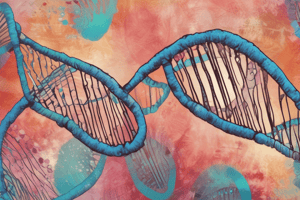Podcast
Questions and Answers
What does a 'knockdown' of gene expression imply?
What does a 'knockdown' of gene expression imply?
- A variable reduction of gene expression (correct)
- Complete elimination of gene expression
- Permanent removal of the gene
- No change in gene expression
Which method can be used for permanent knockdown of gene expression?
Which method can be used for permanent knockdown of gene expression?
- Direct gene editing with CRISPR
- Transitory RNA insertion via injection
- RNA interference using siRNA
- Introduction of a dsRNA transgene (correct)
What is a significant weakness of RNA interference (RNAi) in certain organisms?
What is a significant weakness of RNA interference (RNAi) in certain organisms?
- It permanently degrades all RNA
- It cannot target specific genes
- It is not applicable in some eukaryotes (correct)
- It requires excessive amounts of RNA
What advantage does RNAi provide in gene expression control?
What advantage does RNAi provide in gene expression control?
What process is characterized by full complementarity in RNAi?
What process is characterized by full complementarity in RNAi?
What is a primary use of high-resolution genetic maps?
What is a primary use of high-resolution genetic maps?
How can linking molecular markers assist in genetic counseling?
How can linking molecular markers assist in genetic counseling?
What does marker-assisted breeding leverage to identify desirable traits?
What does marker-assisted breeding leverage to identify desirable traits?
What information is typically found on a high-resolution genetic map?
What information is typically found on a high-resolution genetic map?
How does understanding the linkage between markers help in genetic research?
How does understanding the linkage between markers help in genetic research?
What is the significance of genotyping specific markers like A1 and C4 in marker-assisted breeding?
What is the significance of genotyping specific markers like A1 and C4 in marker-assisted breeding?
In the context of genetic risk assessment, what does tracking a pathogenic variant allow?
In the context of genetic risk assessment, what does tracking a pathogenic variant allow?
What is a characteristic feature of a genetic marker in relation to mutations?
What is a characteristic feature of a genetic marker in relation to mutations?
What is the primary reason that PCR amplification is beneficial in STR DNA profiling?
What is the primary reason that PCR amplification is beneficial in STR DNA profiling?
How are different microsatellite loci distinguished in multiplex PCR?
How are different microsatellite loci distinguished in multiplex PCR?
What does a single large band at a locus in capillary electrophoresis indicate?
What does a single large band at a locus in capillary electrophoresis indicate?
Why are SNPs not preferred for building unique DNA profiles compared to STRs?
Why are SNPs not preferred for building unique DNA profiles compared to STRs?
What is the significance of the independence of loci in DNA profiling?
What is the significance of the independence of loci in DNA profiling?
What is a potential drawback of using PCR in STR profiling?
What is a potential drawback of using PCR in STR profiling?
In forensic applications, what does a match between a suspect's DNA profile and a crime scene sample typically suggest?
In forensic applications, what does a match between a suspect's DNA profile and a crime scene sample typically suggest?
What occurs when multiple peaks are detected at a specific locus during STR profiling?
What occurs when multiple peaks are detected at a specific locus during STR profiling?
How is probability used in interpreting DNA profiles?
How is probability used in interpreting DNA profiles?
In the context of STR DNA profiling, what is the role of capillary typing?
In the context of STR DNA profiling, what is the role of capillary typing?
What is a primary strength of Forward Genetics?
What is a primary strength of Forward Genetics?
What is a disadvantage of Reverse Genetics?
What is a disadvantage of Reverse Genetics?
What process is involved in altering gene expression through Reverse Genetics?
What process is involved in altering gene expression through Reverse Genetics?
Which of the following describes recombinant viruses in the context of Reverse Genetics?
Which of the following describes recombinant viruses in the context of Reverse Genetics?
Which gene manipulation method alters gene function through the introduction of DNA?
Which gene manipulation method alters gene function through the introduction of DNA?
What is a common feature of transient gene knockdown approaches such as RNAi?
What is a common feature of transient gene knockdown approaches such as RNAi?
Which method can make the cell's membrane more permeable for DNA transfer?
Which method can make the cell's membrane more permeable for DNA transfer?
What role does Dicer play in the RNA interference pathway?
What role does Dicer play in the RNA interference pathway?
What is a characteristic of viral methods in gene manipulation?
What is a characteristic of viral methods in gene manipulation?
Which of these is a technique used in gene knockout approaches?
Which of these is a technique used in gene knockout approaches?
What will be observed on a gel when homozygous individuals for a morph with a restriction enzyme are analyzed?
What will be observed on a gel when homozygous individuals for a morph with a restriction enzyme are analyzed?
Which method uses labelled probes to bind to regions of DNA with restriction sites?
Which method uses labelled probes to bind to regions of DNA with restriction sites?
What indicates a polymorphism when using allele-specific oligonucleotide (ASO) probes?
What indicates a polymorphism when using allele-specific oligonucleotide (ASO) probes?
What is one limitation of using RFLP genotyping?
What is one limitation of using RFLP genotyping?
When heterozygous individuals are run on a gel after PCR amplification, how many strands will be observed?
When heterozygous individuals are run on a gel after PCR amplification, how many strands will be observed?
In the probe-based method, how many ASO probes are needed to distinguish between three genotypes of a SNP locus?
In the probe-based method, how many ASO probes are needed to distinguish between three genotypes of a SNP locus?
What will occur if a probe does not bind well to a polymorphic site during analysis?
What will occur if a probe does not bind well to a polymorphic site during analysis?
The regions the labelled probes bind to during analysis are adjacent to what feature?
The regions the labelled probes bind to during analysis are adjacent to what feature?
Flashcards are hidden until you start studying
Study Notes
RFLP Identification Options
- RFLPs can be identified through two methods: PCR amplification and labeled probes.
Option 1: PCR Amplification
- Amplifies a genomic region containing the restriction cut site.
- Amplified strands are subjected to restriction enzyme digestion and gel electrophoresis.
- Homozygous individuals for the restriction site show two strands, while those without show one.
- Heterozygous individuals display one strand for each variant.
Option 2: Labeled Probes
- Genomic DNA is digested, and labeled probes bind to regions around the restriction site.
- Presence of the restriction site results in two bands on a gel due to probe binding.
- Allele-specific oligonucleotide (ASO) is utilized for high-throughput analysis.
- Probes do not bind completely to polymorphic strands, leading to instability at higher temperatures.
Challenges in RFLP Genotyping
- Many small variants do not affect restriction sites, leading to random changes.
- Traditional RFLP genotyping is not high-throughput and complex.
- ASO probe hybridization can identify alleles in a more efficient manner.
Traditional and Continuing Applications
- High-resolution genetic maps facilitate gene mapping and cloning.
- Identifying mutations affecting different genes and tracking mutant phenotypes via molecular markers.
- Useful in identifying rare disease-causing alleles and tagging alleles in breeding.
- Genetic markers assist in genetic counseling and genome sequence assembly.
Example: Marker-Assisted Breeding
- Markers can tag desirable alleles, such as the 'Bold' gene in plants.
- Screening neighboring markers A and C to identify plants that carry the desired allele, skipping the lengthy observation of trait appearance.
Genetic Risk Counseling Example
- Tracking pathogenic variants to assign genetic risk, exemplified by Huntington’s Disease.
- STR DNA profiling utilizes highly polymorphic microsatellite loci to create a unique DNA profile.
Advantages and Disadvantages of PCR Amplification
- Pros:
- PCR is highly sensitive; small DNA amounts suffice.
- Effective on degraded DNA, with clear allele identification.
- Cons:
- Contaminating DNA can easily amplify, leading to potential inaccuracies.
Multiplexing in PCR-based STR Profiling
- Multiple PCR reactions can occur in a single run.
- DNA fragments separated by gel electrophoresis based on size.
- Peaks in capillary electrophoresis indicate heterozygosity or homozygosity.
Advances and Limitations in SNP Profiling
- SNPs are abundant, requiring more loci for adequate profiling.
- Applicable for studies involving degraded DNA and evolutionary lineage.
DNA Profile Interpretation
- Probability assessments of allele frequency determine profile uniqueness.
- Independent loci are multiplied for overall probability.
Forensic Applications
- STR analysis compares crime scene samples with suspects.
- Matches provide evidence for ruling in/out potential suspects.
Genetics Strategy Types
- Forward Genetics: Unbiased approach, discovering phenotypes through random mutagenesis, but can complicate mapping impacted genes.
- Reverse Genetics: Starts with known genes to understand function via gene manipulation through techniques like recombinant DNA technology.
Gene Delivery Methods
- Viral: Packaged DNA or RNA delivered into cells using recombinant viruses.
- Non-Viral: Methods include physical injection and chemical alteration of the cell membrane to facilitate DNA transfer.
Gene Knockdown Techniques
- RNA interference (RNAi) reduces mRNA levels targeting specific genes.
- Mechanism involves converting pri-miRNA to active forms that target and degrade mRNA.
- Knockdown can be transient or permanent depending on the introduction method.
RNAi Strengths and Weaknesses
- Strengths:
- Provides temporal and spatial control over gene expression.
- Applicable to a broad range of eukaryotic organisms.
- Weaknesses:
- Limited effectiveness in specific organisms, such as yeast and select fish.
- Variability in knockdown efficiency across different genes.
Studying That Suits You
Use AI to generate personalized quizzes and flashcards to suit your learning preferences.




